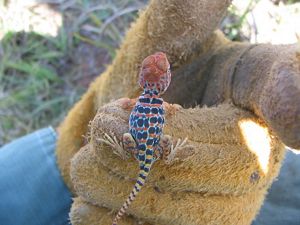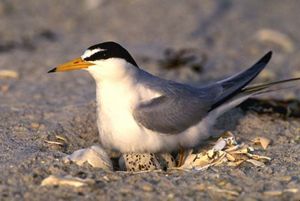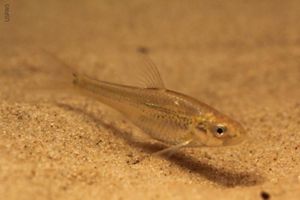Southern High Plains
Across five states and 71 million acres, TNC is conserving the lands and waters of this region to boost climate resilience, preserve biodiversity and support sustainable agricultural communities.

Peaks and Valleys at 4CP Four Canyon Preserve © by Jay Pruett/The Nature Conservancy
In the open expanses of western Oklahoma lies a stretch of rugged canyons, rolling prairie and steep bluffs overlooking the Canadian River. “Four Canyon Preserve has been shaped over millennia by a harsh climate, grazing by wildlife like bison and periodic fire,” says Chris Hise, preserve manager and Oklahoma associate director of conservation. “Although the landscape is unforgiving, this place is inherently and undeniably beautiful. There is nothing better than hiking across the prairie and listening to nighthawks boom on a warm summer evening.”
This year, The Nature Conservancy in Oklahoma celebrates twenty years of stewardship at Four Canyon Preserve. Located in Ellis County, this is a biodiverse, topographically unique and relatively untouched property. It features essential habitat for grassland birds like Cassin’s sparrow and northern bobwhite, valuable cover for mule deer and varied terrain in which hundreds of native plant species thrive. Since it was established in 2004, Chris has cared for and meticulously restored this land.
Chris calls western Oklahoma home. He grew up in the town of Sayre, about 50 miles away from what would become the preserve. His relationship with TNC began the summer before his senior year of high school, when he entered a statewide environmental essay contest. Along with a dozen fellow young nature enthusiasts, he was invited to tour natural sites across Colorado and Oklahoma, including The Nature Conservancy’s recently established Joseph H. Williams Tallgrass Prairie Preserve near Pawhuska, OK.
While touring the preserve, Chris had the opportunity to hear from Bob Hamilton, preserve manager at the time. The rest is history. “Until then, I didn’t realize this was something I could pursue as a career. That day, I had an ‘ah-ha’ moment that sparked my journey towards TNC. Now, I have the pleasure of calling Bob a friend and colleague.” Hise officially joined the team in the summer of 2000, with conservation in western Oklahoma top of mind.
Four years later, the Oklahoma chapter identified an opportunity to expand its reach and improve thousands of acres in western Oklahoma. As the state’s grasslands diminished and its prairies faced development, TNC and its supporters took decisive action to conserve 3,410 acres in Ellis County. This was it its first acquisition in the Southern High Plains of western Oklahoma. Since that initial purchase, the preserve has grown to a total of 4,050 acres, making it The Nature Conservancy’s fourth largest in the state.
Much like the topography of the preserve, the journey to Four Canyon had its ups and downs. Staff and trustees did their due diligence, made inroads and laid out a clear case for prioritizing the region to key stakeholders. With Chris on board and the deed in hand, the monumental task of establishing a conservation plan began. Conserving the property meant establishing best practices that continue to this day, including the regular treatment of invasive species. Additionally, implementing beneficial land management practices—like reinstating regular burns—was and remains a key priority.
The variety of plants and animals found here is striking. And, the preserve is an example of what’s possible for expanding conservation in this region"
Among the many accomplishments of his tenure, Chris has cleared over 2,000 acres of invasive Eastern redcedar trees. He’s seen fire encourage native plant growth, remove invasive species and improve soil quality across 90% of the preserve. “We still have much to learn. A few years ago, researchers discovered two insect species on the preserve previously unknown to science. This speaks to the conservation potential of this area.” The wealth of biodiversity found on the property has been further explored through surveys, studies and monitoring in partnership with Oklahoma’s top universities. From archaeological analysis to butterfly surveys and plant counts, the work to document species at Four Canyon is robust and ongoing. “The variety of plants and animals found here is striking. And, the preserve is an example of what’s possible for expanding conservation in this region,” Chris remarked.
A wide range of flora and fauna adorn the property, including dense clusters of chinquapin oak in the steep canyon valleys and a variety of native grasses and wildflowers throughout the mixed-grass prairie above. These grasses are some of nature’s most efficient carbon storage facilities, sequestering carbon underground when left undisturbed. A variety of grassland birds call this place home. Migrating sandhill cranes are often observed in and around the Canadian River, which forms the preserve’s southern border. Texas horned lizards and mountain boomers can be seen skittering across the preserve’s signature red dirt, soaking up the sun, searching for insects or taking cover from the occasional thunderstorm.
From lizards and toads to elusive species like the Interior Least Tern and Arkansas River Shiner, Four Canyon Preserve is a hotbed of biodiversity with a variety of suitable habitat for thousands of unique species.





Little in size, big in color: A young collard lizard found at Four Canyon Preserve, OK. © Chris Hise/TNC
1 of 4

Four Canyon: The rolling hills of Four Canyon Preserve in western Oklahoma. © David Joshua Jennings
2 of 4

Interior Least Tern: This small bird can be found nesting on sandbars and shorelines at the Four Canyon and Keystone Ancient Forest Preserves in Oklahoma. © USFWS
3 of 4

Arkansas River Shiner: The Arkansas river shiner is a small minnow that can be found in the Canadian River along the Four Canyon Preserve in Oklahoma. © USFWS
4 of 4
Twenty years is only the beginning. TNC continues to fight for a stable climate and conserve vulnerable species. When asked what’s over the horizon, Chris says he’s optimistic and eager to expand. “We have opportunities to conserve land on a larger scale here than some other parts the state,” Chris said. “We’re looking for new prospects, collaborating with landowners and partners to explore new grassland conservation strategies.”
There’s a bright future ahead for western Oklahoma and Four Canyon Preserve. “No doubt we’ve made great progress, but Four Canyon is just a postage stamp in the expanse of the Southern High Plains,” said Chris. This region spans the prairies where Oklahoma, Colorado, Kansas, New Mexico and Texas converge. Known as a valuable area for grazing cattle, it also holds great significance for nature. He continued, “If we don’t act fast, we could lose the plants and animals that call this place home. Plus, the benefits to people are bountiful. There’s a reason this region is often referred to as one of the world’s ‘breadbaskets,’ with many millions relying on food produced in the Great Plains for their next meal.”
To learn more about Four Canyon Preserve, visit the preserve page or explore below.
Explore our work in western Oklahoma and beyond.
Sign up to receive updates on our ongoing conservation work in western Oklahoma and beyond.